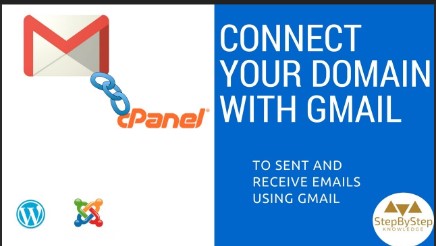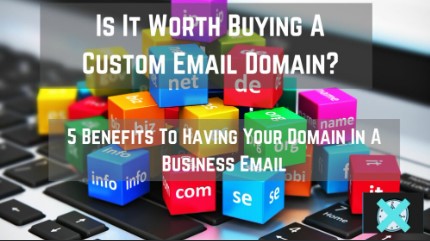Creating Email Domain
Definition and Importance:
An email domain is the part of an email address that comes after the “@” symbol. It usually matches a company’s domain name (like “yourcompany.com”), distinguishing professional correspondence from personal emails that use generic domains like Gmail or Yahoo.
A custom email domain elevates your business communications, making them appear more legitimate and trustworthy to clients and partners. It’s not just a detail; it’s a vital part of your digital identity.
Benefits of a Custom Email Domain:
The primary benefit of a custom email domain is the professional image it projects. It tells recipients that your business is established and credible.
Additionally, a custom email domain enhances brand consistency, making every email a subtle reminder of your business’s presence. It also provides better control over your email addresses, allowing you to create specific addresses for different departments or employees, thereby improving organization and communication efficiency.
Selecting an Effective Domain Name
Branding Considerations:
Your domain name should be a clear reflection of your brand. Choose a name that is simple, memorable, and closely aligned with your business identity.
Avoid complicated strings of characters, overly long names, or anything that might confuse your audience. Think about what potential clients or customers will remember and easily associate with your business.
Domain Extensions:
While “.com” remains the most popular and recognizable extension, there are many others to consider. Options like “.net,” “.org,” and even newer, niche extensions like “.tech” or “.shop” can provide unique opportunities to align with your business type. Country-specific extensions (e.g., “.co.uk,” “.ca”) can also help target local markets more effectively.
Checking Domain Availability
Conducting a Domain Search:
Use domain search tools to check the availability of your desired domain name. Services like WHOIS, Namecheap, or GoDaddy can help you see if your chosen name is available or if it’s already taken. Be prepared with a few alternative names in case your first choice isn’t available.
Domain Registration:
Once you’ve found an available domain name that suits your brand, you’ll need to register it through a domain registrar.
This process typically involves choosing your desired domain, entering your contact information, and completing the payment. Most registrars offer additional services like domain privacy protection, which can shield your details from public view.
Setting Up Your Email Domain
Comparing Hosting Options:
There are numerous email hosting services to choose from, each offering different features and pricing structures.
Google Workspace, Microsoft 365, and Zoho Mail are among the most popular, providing robust email hosting along with additional productivity tools. Compare their offerings based on storage space, user limits, integration capabilities, and cost to find the best fit for your needs.
Evaluating Features and Pricing:
Look beyond the initial cost and consider the overall value. Features such as spam filtering, encryption, mobile access, and support are crucial. Additionally, some providers offer scalable plans that allow you to start small and grow as your needs expand, which can be particularly advantageous for small businesses anticipating growth.
Configuring DNS Settings
Accessing DNS Management:
Once you’ve registered your domain and chosen a hosting provider, you’ll need to configure your DNS settings. This usually involves logging into your domain registrar’s account and navigating to the DNS management section. This process can vary slightly depending on your registrar, but generally follows a similar structure.
Adding MX Records:
To ensure emails sent to your domain are properly directed to your email server, you need to add Mail Exchange (MX) records. These records tell email servers where to deliver messages sent to your domain. Your email hosting provider will give you the specific MX record settings to input, which typically include the server name and priority.
Setting Up User Accounts
Creating Individual Email Addresses:
With your domain and hosting configured, it’s time to create individual email addresses. This involves logging into your email hosting provider’s admin console and setting up new user accounts. For each account, you’ll assign a unique username (such as john@yourcompany.com) and password.
Assigning Aliases and Forwarding:
Email aliases can be useful for creating generic addresses like info@yourcompany.com or support@yourcompany.com, which can then be forwarded to specific user accounts. This helps manage communication more efficiently and presents a unified front to your customers.
Managing Storage and Quotas
Allocating Storage Space:
Different email hosting plans come with varying amounts of storage. It’s important to manage this space wisely to ensure you don’t run out of room. Set storage quotas for each user to prevent any one account from using too much space.
Monitoring Usage:
Regularly check your storage usage to identify trends and anticipate future needs. Many hosting providers offer tools and dashboards that make it easy to monitor how much space each user is consuming.
Enhancing Security and Deliverability
Enabling SSL/TLS Encryption:
To protect your email communications, ensure that SSL/TLS encryption is enabled. This encryption secures the connection between your email client and the server, preventing unauthorized access to your emails during transit.
Setting Up SPF, DKIM, and DMARC:
Implement these email authentication protocols to protect your domain from being spoofed and to improve email deliverability.
SPF (Sender Policy Framework) specifies which servers are allowed to send emails on behalf of your domain. DKIM (DomainKeys Identified Mail) adds a digital signature to your emails, verifying they haven’t been altered.
DMARC (Domain-based Message Authentication, Reporting, and Conformance) builds on SPF and DKIM, providing a way to report and enforce email policies.
Maintaining Deliverability
Avoiding Spam Filters:
To ensure your emails land in the inbox rather than the spam folder, follow best practices such as avoiding spammy language, maintaining a clean email list, and ensuring your emails are well-formatted and relevant.
Regular Maintenance:
Regularly check for blacklisting and promptly address any issues. Keep your email content relevant and your sending practices consistent to maintain a good sender reputation.
Integrating with Email Clients and Devices
Setting Up Email on Outlook, Gmail, and Apple Mail:
Detailed instructions for configuring your custom email domain on popular email clients ensure seamless access across different platforms. Each client may have slightly different setup steps, but they generally require inputting your email address, password, and server settings provided by your hosting provider.
Syncing Across Devices:
Ensure that your emails are accessible on all your devices by enabling synchronization. This allows you to manage your emails on your desktop, laptop, tablet, and smartphone, ensuring you stay connected no matter where you are.
Using Webmail Interfaces
Accessing Email via Webmail:
Webmail offers a convenient way to access your emails from any browser, without needing to configure an email client. Most email hosting providers offer a webmail interface as part of their service.
Customizing Webmail:
Many webmail interfaces allow for customization, enabling you to tailor the appearance and functionality to better suit your workflow. Look for options to change themes, set up filters, and organize your inbox.
Managing and Scaling Your Email Domain
Regular Backups:
Regular backups are crucial for protecting your email data. Set up automated backup routines to ensure you always have a recent copy of your emails that can be restored in case of data loss.
Troubleshooting Common Issues:
Be prepared to troubleshoot common email problems such as connectivity issues, spam, or configuration errors. Having a basic understanding of these issues can help you quickly resolve them and maintain smooth email operations.
Scaling for Growth
Adding New Users and Domains:
As your organization grows, you’ll likely need to add new email accounts and possibly new domains. Choose an email hosting plan that offers easy scalability to accommodate your expanding needs.
Upgrading Plans and Features:
As your requirements evolve, you may find the need to upgrade your email hosting plan to access additional features, more storage, or better performance. Keep an eye on your usage and be proactive about upgrading to ensure your email system remains efficient and effective.
Conclusion
Summary of Key Steps:
Setting up a custom email domain involves several important steps, from choosing the right domain name and hosting provider to configuring DNS settings and creating email accounts. Each step is crucial for ensuring a professional and reliable email system.
Encouragement to Start:
Establishing your custom email domain can significantly enhance your brand’s professionalism and credibility. Take the first step today and transform your email communications into a powerful branding tool.
Additional Resources
Links to Tutorials and Guides:
For more in-depth instructions and tips, explore additional resources like tutorials and guides that cover various aspects of email domain management.
Support and Community:
Join forums and communities where you can connect with other email domain managers, share experiences, and seek advice. These platforms can be invaluable for troubleshooting issues and staying updated with best practices.





